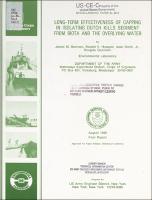Please use this identifier to cite or link to this item:
https://hdl.handle.net/11681/21617Full metadata record
| DC Field | Value | Language |
|---|---|---|
| dc.contributor.author | Brannon, James M. | - |
| dc.contributor.author | Hoeppel, Ronald E. | - |
| dc.contributor.author | Smith, Isaac | - |
| dc.contributor.author | Gunnison, Douglas | - |
| dc.date.accessioned | 2017-03-24T18:03:20Z | - |
| dc.date.available | 2017-03-24T18:03:20Z | - |
| dc.date.issued | 1986-08 | - |
| dc.identifier.uri | http://hdl.handle.net/11681/21617 | - |
| dc.description.abstract | Abstract: At the request of the New York District, the effectiveness of capping in chemically and biologically isolating contaminated dredged material over a 1-year period was investigated using large (250-ℓ) laboratory reactor units. The ability of Edgewater cap material to isolate contaminated Dutch Kills sediment was assessed by following the movement of chemical contaminants and microbial spores contained in the Dutch Kills sediment into the water column and by monitoring the biological uptake of chemical contaminants by the clam, Mercenaria mercenaria. At the conclusion of the year study, sediment cores were obtained from the experimental units and analyzed for chemical contaminants to determine if contaminant movement into the cap had occurred. Results of water column, animal bioaccumulation, and core sampling indicate that capping of contaminated Dutch Kills sediment with either 10 or 50 cm of clean cap material will prevent the movement of detectable amounts of contaminants through the cap material. It is highly likely that the greatest value of a cap is in physically isolating contaminated dredged material from the overlying water and biota. In the absence of bioturbation or physical disturbance, core data revealed that the cap maintained its integrity over the course of a year without mixing with the contaminated sediment. Addition of a 10 cm Edgewater cap, along with a suitable thickness of material to isolate burrowing benthic organisms from the dredged material and prevent current and wave action from removing the cap, should prevent movement of contaminants into the water and biota in the field. | en_US |
| dc.description.sponsorship | United States. Army. Corps of Engineers. New York District. | en_US |
| dc.language.iso | en | en_US |
| dc.publisher | Environmental Laboratory (U.S.) | en_US |
| dc.relation.ispartofseries | Miscellaneous Paper;EL-86-8 | - |
| dc.subject | Marine pollution--Experiments | en_US |
| dc.subject | Contamination (Technology) | en_US |
| dc.subject | Microbiology--Research | en_US |
| dc.subject | Microbial ecology | en_US |
| dc.subject | Environmental engineering | en_US |
| dc.subject | Sedimentation and deposition | en_US |
| dc.subject | Sediment capping | en_US |
| dc.title | Long-term effectiveness of capping in isolating Dutch Kills sediment from biota and overlying water | en_US |
| dc.type | Report | en_US |
| Appears in Collections: | Miscellaneous Paper | |
Files in This Item:
| File | Description | Size | Format | |
|---|---|---|---|---|
| MP EL-86-8.pdf | 6.33 MB | Adobe PDF |  View/Open |